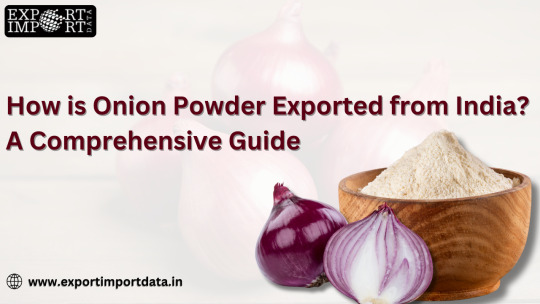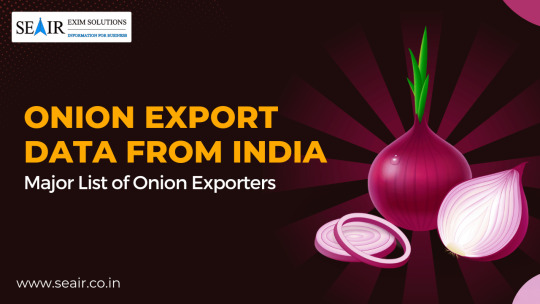#India export data of Onion
Explore tagged Tumblr posts
Text
#Fresh Onion#Organic Onion#Onion#Red Onion#premier Onion#top Onion#Vegetables#supplier#Exporter#Gujarat#India#India export data of Onion#natural onion#onion export data
0 notes
Text
Explore the growing potential of onion powder export from India in 2025. Get insights on onion powder export data, HS codes, top exporters, buyers, and global demand trends.
0 notes
Text
https://www.eximpedia.app/blog/onion-powder-export-from-india
Discover key insights on onion powder export from India, including HS Codes, major export destinations, and top exporters. Learn how to find verified global buyers with Eximpedia’s data-driven tools.

#onion powder export from India#onion powder export data#onion powder HS code#onion powder export#dry onion powder export from India#organic onion powder#onion powder exporters in India
0 notes
Text
Unlocking the Potential of Onion Exports from India: Insights, Opportunities, and Trends

Onion exports from India play a vital global role, backed by strong production, variety, trade ties, and growing international demand.
#onion exports from India#onion export data#onion export data from india#Indian onion exporters#top onion exporting countries#onion exporter in india#top onion exporters in india
0 notes
Text
Onion Powder Export from India: Key Insights and Future Trends

Discover our latest blog on onion powder exports from India. You'll have access to real-time onion powder export data, HS Codes and exporters.
#onion powder export from india#onion powder export data#onion powder hs code#onion powder export#dry onion powder export from india#organic onion powder
0 notes
Text
How is Onion Powder Exported from India? A Comprehensive Guide

India has emerged as a significant player in the global spice market, with onion powder being one of the major commodities it exports. This article answers the most common questions related to onion powder export from India, including its export trends, associated data, and important details like HS codes and organic options. Let's dive in!
What is the Role of India in the Global Onion Powder Export Market?
India is one of the largest producers and exporters of onion powder globally. Known for its high-quality agricultural produce, the country supplies onion powder to various international markets. The primary reasons for India's strong presence in the market include its massive agricultural output, cost-effective production, and adherence to global quality standards.
What is Onion Powder Export Data, and Why is it Important?
Onion powder export data refers to statistics and figures that highlight India’s exports of this product. It includes details like the volume, value, export destinations, and trends over time. This data is crucial for businesses and investors as it helps them analyze market potential, growth opportunities, and key global markets.
For instance, in recent years, India has seen a consistent rise in the demand for onion powder, with exports reaching multiple countries across Asia, Europe, and the Middle East. This reflects India's growing dominance in the spice export market.
Which Countries Import Onion Powder from India?
India exports onion powder to various countries around the world. Some of the major importers include:
United States: A significant market due to its demand for processed foods. United Kingdom: High demand for organic onion powder in this region. Germany: Known for importing large volumes of dry onion powder for the food processing industry. United Arab Emirates: A critical market for Indian onion powder exporters. These regions prefer Indian onion powder for its strong flavor and quality, which is unmatched in the global market.
What is the HS Code for Onion Powder Export from India?
The HS code (Harmonized System Code) is a standardized system for identifying and classifying products during export and import. For onion powder, the HS code is 071220.
This code is vital for businesses as it ensures smooth customs clearance and helps classify the product correctly in international trade.
What is the Process of Dry Onion Powder Export from India?
Exporting dry onion powder from India involves several steps to ensure quality and compliance with international regulations:
Production: Fresh onions are dried and ground into powder form. Organic onion powder is also gaining popularity due to increasing consumer preference for chemical-free products. Packaging: The powder is packaged in airtight, export-grade packaging to retain freshness and flavor. Compliance: Exporters adhere to global food safety standards and obtain necessary certifications like FSSAI, ISO, and HACCP. Shipping: Onion powder is then transported to international markets via sea or air.
Why is Organic Onion Powder in High Demand?
Organic onion powder is cultivated without synthetic chemicals, pesticides, or fertilizers, making it a healthier and environmentally friendly alternative. This product has seen an increase in demand, particularly in countries like the United States and Europe, where consumers prioritize organic and sustainable products.
Indian exporters are leveraging this trend by focusing on organic onion powder production and export.
How Can Businesses Access Onion Powder Export Data from India?
Businesses can access onion powder export data through:
Government Websites: Portals like APEDA (Agricultural and Processed Food Products Export Development Authority) provide reliable export statistics. Trade Analysis Platforms: Websites like TradeMap offer insights into India’s onion powder exports, including destination countries and trade volumes. Custom Reports: Many private agencies provide detailed export data, customized for specific business needs.
What are the Challenges in Onion Powder Export from India?
While onion powder export from India has grown significantly, it faces challenges such as:
Price Volatility: The price of raw onions fluctuates, impacting production costs. Quality Standards: Meeting the stringent food safety standards of international markets can be demanding. Logistics Issues: Delays in shipping or storage can compromise product quality. Despite these challenges, India's exporters have consistently adapted to meet global demands.
What Makes India a Preferred Exporter of Dry Onion Powder?
India’s dominance in the dry onion powder export market is due to:
High-Quality Produce: Indian onion powder has a strong flavor and long shelf life. Competitive Pricing: Due to lower production costs, Indian exporters offer competitive prices. Strong Agricultural Base: India has vast onion farming areas, ensuring a steady supply. Advanced Technology: Use of modern drying and processing techniques enhances quality.
What is the Future of Onion Powder Export from India?
The future of onion powder export from India looks promising due to:
Rising Global Demand: The use of onion powder in processed foods is increasing worldwide. Focus on Organic Products: More exporters are transitioning to organic onion powder to cater to health-conscious consumers. Technological Advancements: Innovations in packaging and processing will further boost export quality.
How Can New Exporters Enter the Market?
New exporters looking to enter the onion powder export market should:
Understand Export Regulations: Familiarize themselves with India's export policies and the onion powder HS code. Build Strong Supply Chains: Ensure a reliable source of high-quality onions. Invest in Marketing: Establish their brand in key international markets. Focus on Organic Production: Tap into the growing demand for organic onion powder.
What are Some Key Facts About Onion Powder Export?
Onion powder export from India has seen double-digit growth in the past five years.
The United States is one of the largest importers of Indian onion powder.
Organic onion powder commands a higher price in international markets.
What Packaging is Used for Onion Powder Exports?
To retain the freshness and quality of onion powder during transit, exporters use:
Vacuum-sealed bags
Food-grade containers
Bulk packaging options for large-scale buyers
How Do Exporters Ensure Quality Compliance?
Indian exporters follow strict quality guidelines to meet international standards. This includes:
Obtaining certifications like FSSAI, ISO, and HACCP
Regular quality testing
Ensuring the product is free from contaminants
Is Onion Powder Export a Profitable Business?
Yes, onion powder export from India is a profitable venture due to:
Growing global demand for spices and processed foods. Increasing preference for organic and dry onion powder. India’s ability to produce high-quality onion powder at competitive rates.
Conclusion
Onion powder export from India is a thriving industry with immense potential for growth. With robust export data, high-quality production, and rising global demand, Indian exporters are well-positioned to dominate the market. Whether you are an established player or a new entrant, understanding the nuances of this business, from HS codes to organic production, can set you up for success.
#onion powder export from India#onion powder export data#dry onion powder export from India#organic onion powder#onion powder hs code
0 notes
Text

Dive into the lucrative world of onion export from India with Eximpedia. Discover essential insights and effective strategies to thrive in this profitable business landscape. Unlock the potential of onion exports and stay ahead of the competition with our comprehensive guide.
0 notes
Text
Explore latest onion export data from India market dynamics, production trends and major export destinations. Get information about top onion exporters, market challenges and strategies for success in the global onion trade.
#onion export data from india#onion export data#onion exporter#indian onion exporters#onion exporter in india#onion export from india#onion export
0 notes
Text
0 notes
Text
India's Flourishing Vegetables Export Industry: A Detailed Insight

India, with its vast agricultural resources and diverse climate, has established itself as a significant player in the global vegetables market. The country's vegetables export from India has seen remarkable growth, contributing to the economy and meeting international demand for fresh and dehydrated vegetables. This article delves into the nuances of vegetables export from India, examining key data, leading exporters, and major importing countries.
The Significance of Vegetables Export from India
India's agriculture sector plays a crucial role in the economy, with vegetables forming a substantial part of the export portfolio. The country's rich soil and varied climatic conditions allow for the cultivation of a wide range of vegetables, which are exported to numerous countries worldwide.
Overview of Vegetables Export Data
Vegetables export data indicates a robust and growing industry. In recent years, India has exported millions of tonnes of vegetables, generating substantial revenue. The vegetables hs code, which is the harmonized system code used to classify goods in international trade, for fresh and dehydrated vegetables falls under chapters 07 and 20 respectively, helping streamline and categorize the export process.
List of Vegetables Exported from India
India exports a diverse range of vegetables, both fresh and dehydrated. The list of vegetables exported from India includes:
Onions
Potatoes
Tomatoes
Green chilies
Okra
Eggplants
Carrots
Spinach
Cabbages
Cauliflowers
Most Exported Vegetables from India
Among these, the most exported vegetables from India are onions, potatoes, and tomatoes. These vegetables are in high demand due to their versatility, nutritional value, and extensive use in various cuisines around the world.
Export of Dehydrated Vegetables from India
In addition to fresh vegetables, the export of dehydrated vegetables from India has also gained momentum. Dehydrated vegetables, such as dried onions, garlic, and green beans, offer longer shelf life and ease of transport, making them a preferred choice for many international markets. Dehydrated vegetables exporters in India have capitalized on this demand, ensuring high-quality products through advanced processing techniques.
Vegetables Exporters in India
India boasts numerous reputable vegetables exporters who have established a strong presence in the global market. These exporters ensure that Indian vegetables meet international quality standards and are delivered fresh. Some of the leading names include:
Allanasons Pvt Ltd
Tirupati Balaji Agro Products Pvt Ltd
Atmiya International
S K Fresh Produce
K M Exports
Major Vegetable Importing Countries
The list of vegetable importing countries from India includes several major economies and emerging markets. The primary vegetable importing countries from India are:
United Arab Emirates
Saudi Arabia
Bangladesh
Malaysia
Sri Lanka
United Kingdom
Netherlands
Nepal
Qatar
Germany
These countries import significant quantities of Indian vegetables due to their high quality, competitive pricing, and the reliability of Indian exporters.
India's Position Among Top Vegetable Exporting Countries
India is consistently ranked among the top 10 vegetable exporting countries in the world. The country's strategic advantage lies in its ability to produce a wide variety of vegetables throughout the year, ensuring a steady supply to international markets.
Challenges Faced by Vegetable Exporters in India
Despite the success, vegetables exporters in India face several challenges, including:
Quality Control: Maintaining consistent quality to meet international standards.
Logistics: Ensuring efficient cold chain logistics to preserve the freshness of vegetables.
Regulatory Compliance: Navigating various international trade regulations and phytosanitary standards.
Climate Variability: Dealing with the impact of climate change on crop yields.
Government Support and Initiatives
The Indian government has implemented several initiatives to support vegetables export from India. Schemes such as the Agricultural and Processed Food Products Export Development Authority (APEDA) provide financial assistance, quality control support, and market access initiatives to boost exports.
Sustainability and Organic Farming
Sustainability is becoming a focal point in the agriculture sector. Many Indian farmers and exporters are adopting organic farming practices to meet the growing global demand for organic produce. This shift not only enhances the marketability of Indian vegetables but also promotes environmental conservation and soil health.
Technological Advancements in Vegetable Farming
Technological advancements are playing a pivotal role in enhancing the efficiency and productivity of vegetable farming in India. Innovations such as precision farming, drip irrigation, and controlled environment agriculture are helping farmers increase yields and improve quality.
Future Prospects of Vegetables Export from India
The future of vegetables export from India looks promising, with increasing global demand for fresh and high-quality produce. Expanding market access, improving logistics infrastructure, and adopting sustainable farming practices are expected to drive growth in this sector. Additionally, the rise of e-commerce platforms is opening new avenues for direct-to-consumer sales, further boosting exports.
Conclusion
The vegetables export industry in India is a dynamic and vital component of the agricultural sector. With a diverse range of high-quality vegetables, reliable exporters, and strong government support, India continues to strengthen its position in the global market. As the industry navigates challenges and embraces innovation, the future of vegetables export from India looks bright and full of potential.
#vegetables export from india#vegetables export data#vegetables hs code#india vegetable export#vegetables exporters in india#vegetables importers#vegetable importing countries#top 10 vegetable exporting countries#list of vegetables exported from india#export of dehydrated vegetables from india#vegetable importing countries from india#dehydrated vegetables exporters india#most exported vegetables from india
0 notes
Text
India import export data | Global Import export data provider
Exim Trade Data experts are continuously working in the import-export sector just to update the data on a weekly basis. Our database contains more than 200+ countries' import-export data with visual graphs so that the clients who are using our database can understand it easily. India to begin onion exports to Bahrain, Bhutan and Mauritius. You also can check out the sample of India Import Export Data by clicking the below link -https://eximtradedata.com/india-import-export-data
More information about India's plastics exports up 5% during January : https://globalimportexportdataprovider.blogspot.com/2024/03/indias-plastics-exports-up-5-during.html

#indiaimportexportdata#indiacustomsdata#globalimportexportdata#Indiaimportdata#indiashipmentdata#indiatradedata#indiaexportdata#importexportdata#globalimportexportdataprovider
0 notes
Text
How India Dominates the World in Onion Exports?
In this journey, we delve into the intriguing tale of “The Onion Odyssey.” From import data in Indonesia to Canada, India’s influence on the onion market is undeniable. Let’s unravel the layers of this success story. Read more:
0 notes
Text
0 notes
Text
Understanding the Dynamics of Vegetable Export from India

India, a country renowned for its agricultural prowess, has been making significant strides in the vegetable export sector. With its diverse climate and fertile soil, India produces a wide range of vegetables that are in high demand across the globe. The vegetable export industry not only boosts the nation's economy but also supports the livelihoods of millions of farmers. In this article, we'll delve into the various facets of vegetable export from India, including key data, major players, top exported vegetables, and the process of exporting vegetables from India.
The Growth of Vegetable Export from India
The vegetable export from India has seen a remarkable increase over the past few decades. According to the Agricultural and Processed Food Products Export Development Authority (APEDA), India exported vegetables worth approximately USD 1.62 billion in the financial year 2022-23. This figure underscores the significant role that vegetable export plays in India's overall agricultural export portfolio. The rising demand for Indian vegetables in international markets is driven by their quality, diversity, and competitive pricing.
Analyzing Vegetable Export Data
Examining vegetable export data provides valuable insights into trends and growth patterns. For instance, in 2022-23, the export volume of vegetables from India stood at around 2.6 million metric tons. This data indicates a steady increase in both the volume and value of vegetable exports over the years. The top destinations for Indian vegetables include the United Arab Emirates, Bangladesh, Malaysia, Sri Lanka, and the United Kingdom. These countries appreciate the freshness and quality of Indian produce, making them major importers.
Major Players in the Vegetable Export Industry
When it comes to the top vegetable exporters in India, several companies have established themselves as leaders in the industry. Organizations like Mother Dairy, Mahindra Agri Solutions, and ITC Limited have made significant contributions to the vegetable export market. These companies have developed robust supply chains, ensuring that vegetables reach international markets in the best possible condition. Additionally, numerous small and medium enterprises (SMEs) are also making their mark by exporting niche and organic vegetables, thus contributing to the sector's growth.
Top 10 Vegetables Exported from India
India's vast agricultural landscape allows it to produce a variety of vegetables that are popular in global markets. Here are the top 10 vegetables exported from India:
Onions: India is one of the largest exporters of onions, known for their pungency and flavor. Indian onions are particularly popular in Southeast Asia and the Middle East.
Potatoes: Indian potatoes are in demand due to their versatility and quality, finding markets in countries like Nepal, Sri Lanka, and the UAE.
Tomatoes: Both fresh and processed tomatoes from India are sought after in the Middle East and European countries.
Okra (Lady Finger): Okra is a staple in many African and Middle Eastern cuisines, making it a significant export item.
Cabbage: Indian cabbage is appreciated for its quality and is exported mainly to Asian countries.
Carrots: With high demand for fresh and processed carrots, India exports them to various countries, including Malaysia and Bangladesh.
Green Peas: Frozen green peas from India are popular in Western markets due to their quality and availability.
Eggplants (Brinjal): Indian eggplants are favored for their taste and are exported to Asian and European markets.
Bitter Gourd: Known for its health benefits, bitter gourd has a niche market, particularly in Asian countries.
Spinach: Both fresh and frozen spinach from India cater to health-conscious consumers worldwide.
Steps to Export Vegetables from India
For those looking to enter the vegetable export business, understanding the process is crucial. Here’s a step-by-step guide on how to export vegetables from India:
Obtain Required Licenses and Registrations: The first step is to get an Importer Exporter Code (IEC) from the Directorate General of Foreign Trade (DGFT). Additionally, registering with APEDA is essential for certification and other support.
Ensure Quality Control: Maintaining high quality is vital. This involves proper farming practices, hygienic packaging, and adherence to international standards such as HACCP and ISO.
Market Research: Conduct thorough research to identify potential markets. Analyze the demand, competition, and pricing strategies in different countries.
Develop a Supply Chain: Establish a robust supply chain to ensure that vegetables remain fresh from the farm to the international markets. This includes efficient logistics, cold storage facilities, and reliable transportation.
Build Networks: Establish connections with international buyers, distributors, and wholesalers. Participating in trade fairs and exhibitions can help in building these networks.
Compliance with Regulations: Ensure compliance with the export regulations of both India and the importing country. This includes proper documentation like the shipping bill, certificate of origin, and phytosanitary certificate.
Financial Management: Arrange for secure payment methods and be aware of foreign exchange regulations to mitigate financial risks.
Challenges in the Vegetable Export Sector
Despite its growth, the vegetable export industry in India faces several challenges. Perishability is a major concern, requiring efficient cold chain logistics. Quality control is another critical issue, as international markets have stringent standards. Additionally, competition from other vegetable-exporting countries and fluctuating global prices add to the complexities. Addressing these challenges requires investment in infrastructure, adoption of advanced technologies, and continuous market research.
Conclusion
Vegetable export from India is a vibrant and expanding industry with immense potential. The country's diverse agricultural resources, coupled with increasing global demand, position India as a significant player in the international vegetable market. By focusing on quality, efficient supply chain management, and understanding market dynamics, Indian exporters can continue to thrive. The vegetable export sector not only contributes to the economy but also showcases India's agricultural expertise on a global platform.
#Vegetable export from India#Vegetable export data#Vegetable export#Top vegetable exporters in India#Top 10 vegetables exported from india#How to export vegetables from India
0 notes
Text
https://www.seair.co.in/blog/onion-export-data-from-india-major-list-of-onion-exporters.aspx

Unlock valuable insights into onion export data from India with Seair Exim Solutions' latest blog. Explore a comprehensive list of major onion exporters and gain crucial market intelligence for your trade endeavors.
#onion export data from india#onion export data#onion exporter#indian onion exporters#onion exporter in india#onion export from india#onion export
0 notes